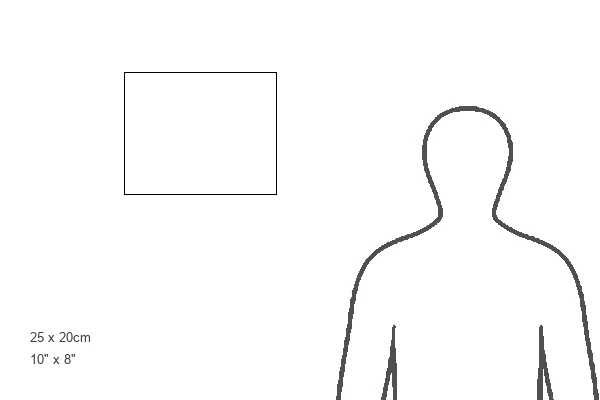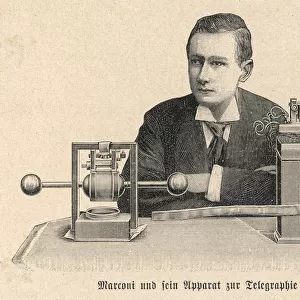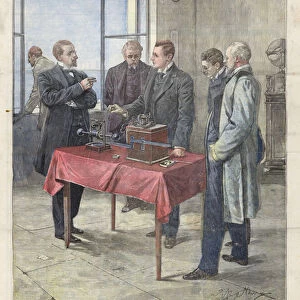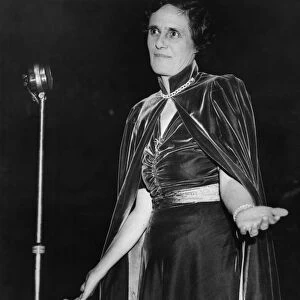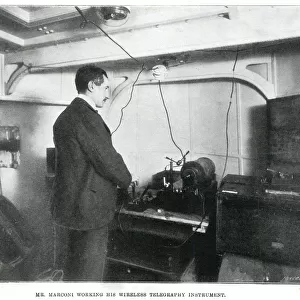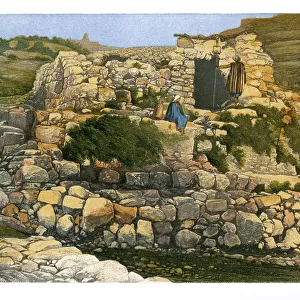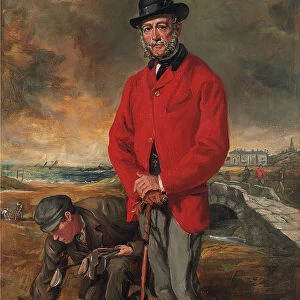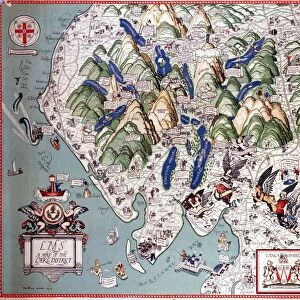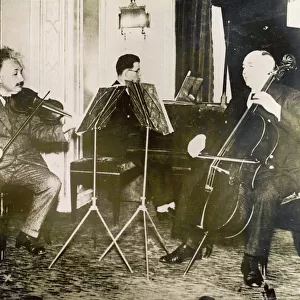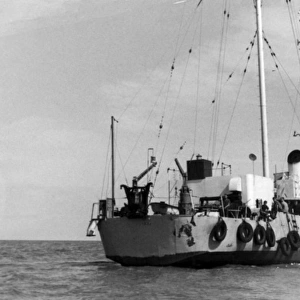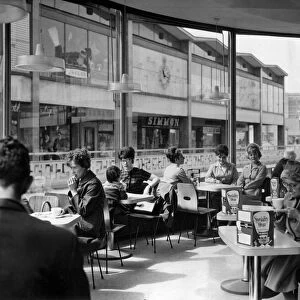Photographic Print > Europe > United Kingdom > England > London > Art > Radio
Photographic Print : Marconi with his radio, 19th century
![]()

Photo Prints from Science Photo Library
Marconi with his radio, 19th century
Marconi with his radio, 19th-century artwork. The apparatus consists of a receiver and a transmitter. Italian physicist Guglielmo Marconi (1874-1937) patented his radio system in Britain and established the Marconis Wireless Telegraph Company in London in 1897. In 1899 he made the first transmission across the English Channel and, in 1901, the first trans-Atlantic transmission. In 1909 he won the Nobel Prize in Physics. He later developed short-wave radio and established a global radio telegraph network. Artwork from the 20th volume (second period of 1897) of the French popular science weekly La Science Illustree
Science Photo Library features Science and Medical images including photos and illustrations
Media ID 6340241
© SCIENCE PHOTO LIBRARY
1890s 1897 Annual Volume Communication Communications Electronics French Guglielmo Marconi Inventor Italian La Science Illustree Louis Figuier Machine Magazine Physicist Popular Science Radio Receiver Transmitter Weekly Mono Chrome
10"x8" (25x20cm) Photo Print
Step back in time with our exquisite Media Storehouse Photographic Print of 'Marconi with his Radio, 19th Century' by Science Photo Library. This captivating image brings to life the groundbreaking moment in history when Italian physicist Guglielmo Marconi (1874-1937) revolutionized communication with his innovative radio technology. Featuring a detailed depiction of Marconi's receiver and transmitter, this print is a stunning addition to any home or office, perfect for history enthusiasts, scientists, or those who appreciate the beauty of scientific discovery. Order now and bring a piece of history into your space.
Ideal for framing, Australian made Photo Prints are produced on high-quality 270 gsm lustre photo paper which has a subtle shimmer adding a touch of elegance, designed to enhance their visual appeal.
Our Photo Prints are in a large range of sizes and are printed on Archival Quality Paper for excellent colour reproduction and longevity. They are ideal for framing (our Framed Prints use these) at a reasonable cost. Alternatives include cheaper Poster Prints and higher quality Fine Art Paper, the choice of which is largely dependant on your budget.
Estimated Image Size (if not cropped) is 25.4cm x 18.8cm (10" x 7.4")
Estimated Product Size is 25.4cm x 20.3cm (10" x 8")
These are individually made so all sizes are approximate
Artwork printed orientated as per the preview above, with landscape (horizontal) orientation to match the source image.
FEATURES IN THESE COLLECTIONS
> Arts
> Literature
> Magazines
> Europe
> United Kingdom
> England
> London
> Art
> Radio
> Europe
> United Kingdom
> England
> London
> Museums
> British Library
EDITORS COMMENTS
This black and white artwork captures the iconic moment when Italian physicist Guglielmo Marconi revolutionized communication with his groundbreaking invention, the radio. The 19th-century illustration showcases Marconi proudly standing beside his remarkable creation - a receiver and transmitter that would change the course of history. Marconi's genius is evident in this image, as he confidently poses next to his invention, which paved the way for modern telecommunications. Patented in Britain and established through the Marconis Wireless Telegraph Company in London, this radio system marked a turning point in human connectivity. The significance of Marconi's achievement cannot be overstated. In 1899, he accomplished an incredible feat by transmitting signals across the English Channel. Just two years later, he achieved another milestone by successfully sending messages across the vast expanse of the Atlantic Ocean. Recognizing his immense contributions to science and technology, Marconi was awarded the Nobel Prize in Physics in 1909. Undeterred by success, he continued to innovate and developed short-wave radio while establishing a global telegraph network. This historical artwork from La Science Illustree beautifully encapsulates both Marconi's ingenuity and its impact on society during that era. It serves as a reminder of how one man's determination can shape our world forever.
MADE IN AUSTRALIA
Safe Shipping with 30 Day Money Back Guarantee
FREE PERSONALISATION*
We are proud to offer a range of customisation features including Personalised Captions, Color Filters and Picture Zoom Tools
SECURE PAYMENTS
We happily accept a wide range of payment options so you can pay for the things you need in the way that is most convenient for you
* Options may vary by product and licensing agreement. Zoomed Pictures can be adjusted in the Cart.



